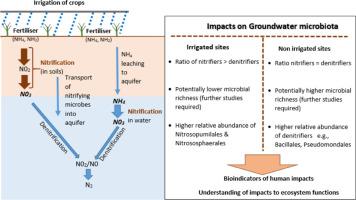Science of the Total Environment ( IF 8.2 ) Pub Date : 2021-10-08 , DOI: 10.1016/j.scitotenv.2021.150870 K L Korbel 1 , P Greenfield 2 , G C Hose 1

|
Irrigation enhances the connectivity between the surface and groundwater by facilitating the transport of energy sources and oxygen. When combined with fertilisers, the impact on groundwater microbial communities and their interactions with nitrogen cycling in aquifers is poorly understood. This study examines the impact of different landuses (irrigated and non-irrigated) on groundwater microbial communities. A total of 38 wells accessing shallow aquifers in three sub-catchments of the Murray Darling Basin, Australia, were sampled for water chemistry and microbial community structure using environmental DNA (eDNA) techniques. All sub-catchments showed evidence of intense irrigation and groundwater contamination with total nitrogen, nitrates and phosphorus concentrations often well above background, with total nitrogen concentrations up to 70 mg/L and nitrate concentration up to 18 mg/L. Across sub-catchments there was high microbial diversity, with differences in community structure and function between catchments and landuses. Of the 1100 operational taxonomic units (OTUs) recorded, 47 OTUs were common across catchments with species from Woesearchaeota, Nitrospirales, Nitrosopumilales and Acidobacter taxonomic groups contributing greatly to groundwater microbial communities. Within non-irrigated sites, groundwaters contained similar proportions of nitrifying and denitrifying capable taxa, whereas irrigated sites had significantly higher abundances of microbes with nitrifying rather than denitrifying capabilities. Microbial diversity was lower in irrigated sites in the Macquarie catchment. These results indicate that irrigated landuses impact microbial community structure and diversity within groundwaters and suggest that the ratios of denitrifying to nitrifying capable microbes as well as specific orders (e.g., Nitrososphaerales) may be useful to indicate long-term nitrogen contamination of groundwaters. Such research is important for understanding the biogeochemical processes that are key predictors of redox state and contamination of groundwater by N species and other compounds. This will help to predict human impacts on groundwater microbial structure, diversity, and ecosystem functions, aiding the long-term management groundwater resources.
中文翻译:

与地下水微生物结构和反硝化细菌变化有关的农业实践
灌溉通过促进能源和氧气的运输来增强地表水和地下水之间的连通性。当与肥料结合使用时,对地下水微生物群落的影响及其与含水层中氮循环的相互作用知之甚少。本研究考察了不同土地利用(灌溉和非灌溉)对地下水微生物群落的影响。使用环境 DNA (eDNA) 技术对进入澳大利亚墨累达令盆地三个子集水区的浅层含水层的 38 口井进行了采样,用于水化学和微生物群落结构。所有子流域都显示出强烈灌溉和地下水污染的证据,总氮、硝酸盐和磷的浓度通常远高于背景,总氮浓度高达 70 mg/L,硝酸盐浓度高达 18 mg/L。子流域之间的微生物多样性很高,流域和土地利用之间的群落结构和功能存在差异。在记录的 1100 个操作分类单位 (OTU) 中,47 个 OTU 在流域中很常见,来自 Woesearchaeota、Nitrospirales、Nitrosopumilales 和 Acidobacter 分类群的物种对地下水微生物群落有很大贡献。在非灌溉地点,地下水含有相似比例的具有硝化和反硝化能力的分类群,而灌溉地点具有显着更高的具有硝化能力而不是反硝化能力的微生物丰度。Macquarie 流域的灌溉地点的微生物多样性较低。这些结果表明灌溉土地利用影响地下水中的微生物群落结构和多样性,并表明反硝化微生物与硝化微生物的比率以及特定的顺序(例如,亚硝化球目)可能有助于指示地下水的长期氮污染。此类研究对于了解生物地球化学过程非常重要,这些过程是氧化还原状态和地下水被 N 物种和其他化合物污染的关键预测因子。这将有助于预测人类对地下水微生物结构、多样性和生态系统功能的影响,有助于地下水资源的长期管理。Nitrososphaerales) 可能有助于指示地下水的长期氮污染。此类研究对于了解生物地球化学过程非常重要,这些过程是氧化还原状态和地下水被 N 物种和其他化合物污染的关键预测因子。这将有助于预测人类对地下水微生物结构、多样性和生态系统功能的影响,有助于地下水资源的长期管理。Nitrososphaerales) 可能有助于指示地下水的长期氮污染。此类研究对于了解生物地球化学过程非常重要,这些过程是氧化还原状态和地下水被 N 物种和其他化合物污染的关键预测因子。这将有助于预测人类对地下水微生物结构、多样性和生态系统功能的影响,有助于地下水资源的长期管理。











































 京公网安备 11010802027423号
京公网安备 11010802027423号